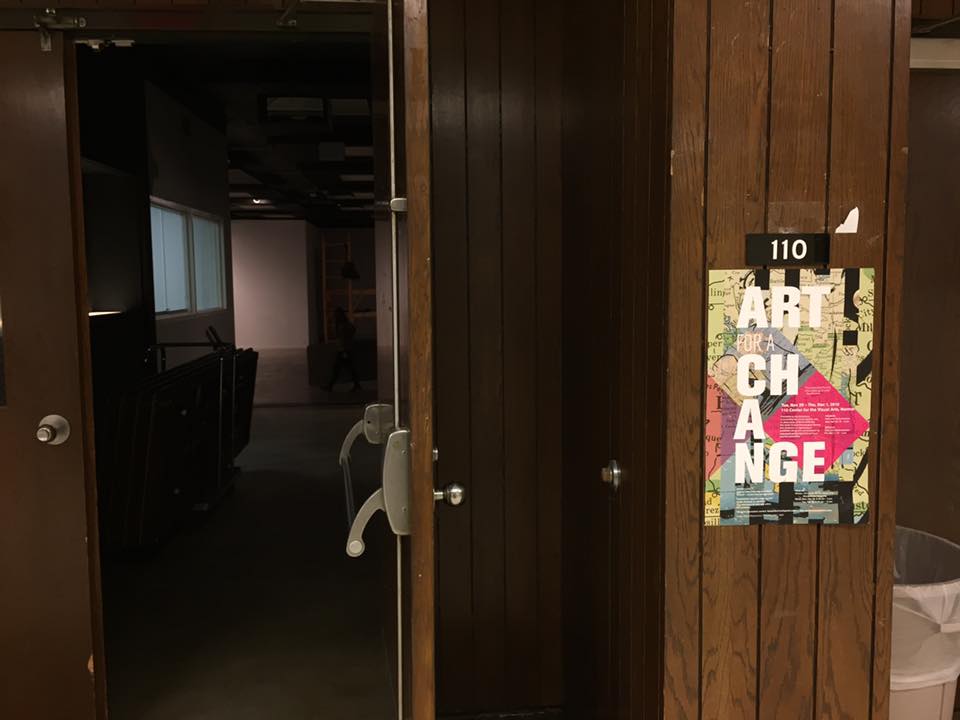Just before the pop-up show Art for a Change opened, Jason Judd (curator for University Galleries at Illinois State University) commented that the exhibition was “one of the ways, and one of the tools in our toolbox, to help be allies with underrepresented groups, to help coordinate and facilitate understanding and a safe place of inclusion.”[1] As a newly formed collective, the BNAC (Bloomington/Normal Arts Collective) set out to prepare such a space for individuals who are compelled to assert their voice without fear of divided public opinion. Over the past few months the collective has garnered student and faculty support, and this show opened many doors for collaboration with regional artists while deepening the connections that ISU has to arts scenes across the Midwest.
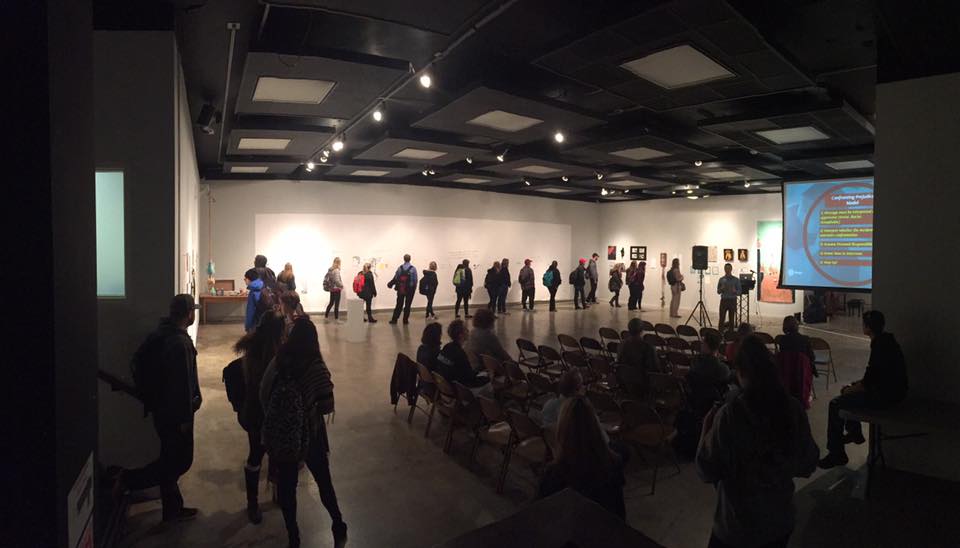
Art for a Change opened inconspicuously on November 30th, but it carried a purpose that would jumpstart this local arts community into action and activation. Merely appearing at the CVA 110 doors was an act of solidarity (the space has been held in reserve for occasional shows since the University Galleries moved), but the pop-up demanded a greater responsibility from the audience than just their attendance. The curating of the show was such that visitors were called to be activists by making a mark that contributed to the preexisting dialogue in the room. The setting was both serene and ephemeral, allowing each visitor a moment to process the local impact of the presidential election and World AIDS Day. Illinois State’s campus was host to a variety of programs and protests over the course of those few days; the Bone Student Center held an exhibit of the National AIDS Quilt accompanied by a keynote speaker on December 1st. That day, Barry Blinderman, Director of University Galleries, paid honor to his friend and peer David Wojnarowicz by giving a lecture on the retrospective that had been shown in the same room nearly a quarter of a century ago. The 40-foot paper wall was a chance to present uninhibited and diverse voices.
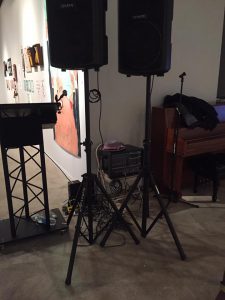
Contributions to the show came in nearly all mediums, including performances and lectures. After Barry’s lecture, university and student representatives provided conversation and support for student concerns. The most compelling part of the show was the way in which all the represented voices spanned generations past and present. One could recall the beginnings of the AIDS crisis and in the same glance ponder the coming administration. Many pieces in fact harkened back to the Reagan administration and the sense of a country denying its division and disease, whether that be physical or cultural.
There is always a risk with pop-up shows that only one perspective will be represented, but there was at least one piece (from Denny Rogers) that was older than those of some of the other local contributors. This seemed to be indicative of potentially contrasting cultural backgrounds, given the varying contexts from which pieces emerged. Design Streak, a student printmaking organization, had completed a work the day before the show was installed, and this sort of urgency mirrored the context in which some of these artists had similarly reacted during past administrations’ characterizations. If the invitation to participate in those day’s events could also allow visitors and contributors to consider the controversial history of arts censorship as expressed in Barry’s show, then it was all the better to leave this space open to spontaneous collaboration and conversation.
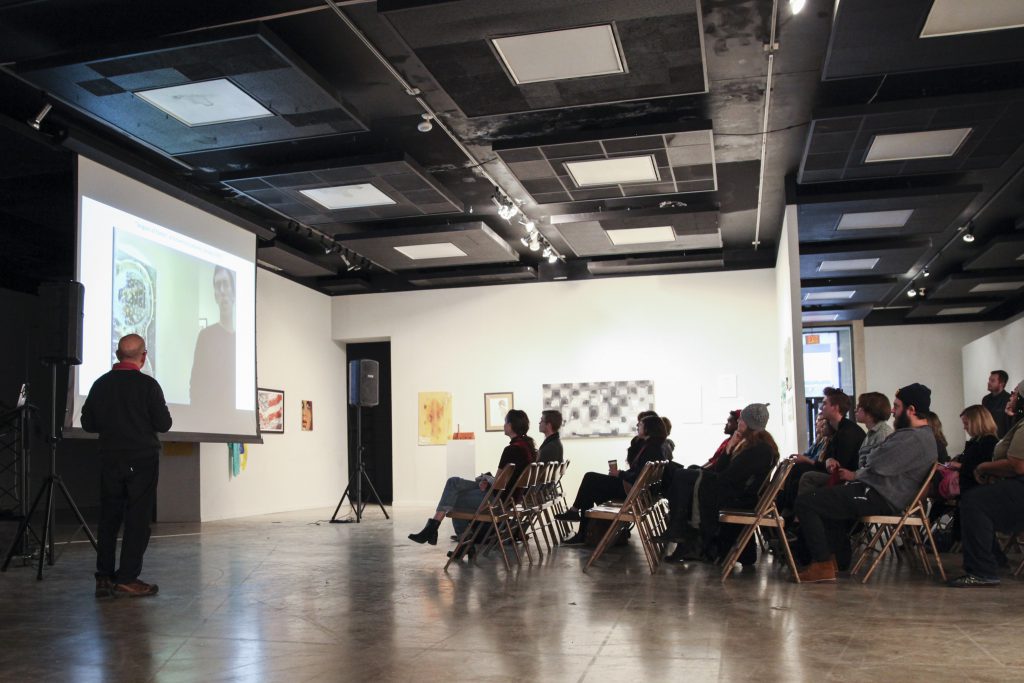
This show ultimately gathered a multitude of voices together rather than single pieces that evoked a homogenous sentiment in the community. Of the variety of people who submitted work, contributors such as Jenny Clay, the documentary photographer Ted Diamond, and Megan Kathol Bersett are all motivated by the process of uncovering or recovering beauty in the everyday. Similarly, others like sculptors Kirsten Heteji, George Barreca, and Ohio native Ryan Burns explore patterns of nature and human history as they relate to our perception and labor. These voices can often become silenced in the days where we memorialize those we’ve lost or when we fight against oppression; however, this focus on a present moment persisted in the first days of December through these artists’ work. In all of these things we might reflect on the changes that are coming to our country as well as the impact on our own corner of town. The Bloomington/Normal Arts Collective moves into the new year with high hopes that such unity will continue no matter how institutional practices change; for now at least, we have our roots in the community to support an alternative group with, as Jason says, “anything that marks you were here.” [2]
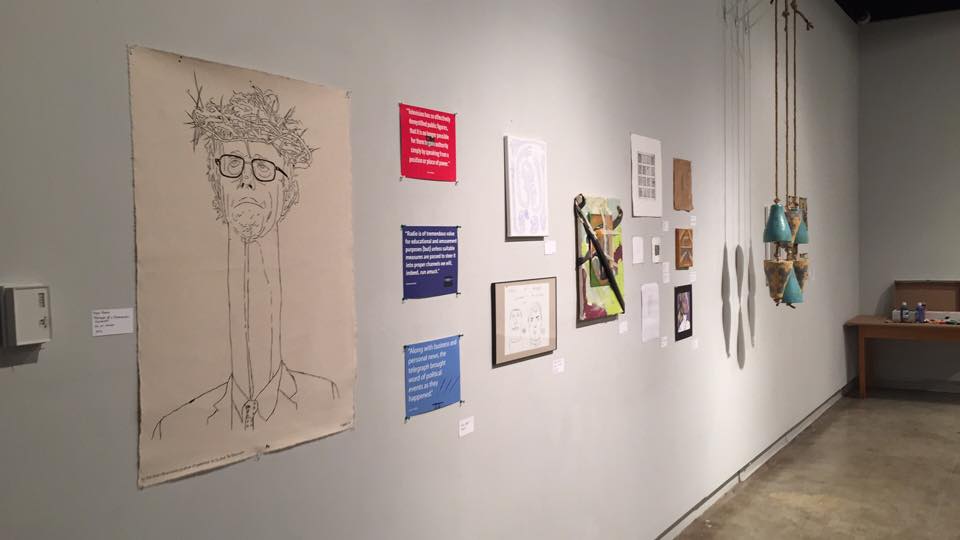
Samantha Comerford, another founding member of the BNAC, offers the below perspective on the power of gathering artists as a response to local unrest in Bloomington/Normal:
On November 9th, 2016 I was floundering. I think many people were. I wasn’t sure what to do or how to do it. How could I channel the storm of emotions I was feeling? Where should I channel all of it? Many Illinois State students had a sit-in and rally on campus where I spent most of my day, and afterwards there was a symposium on gender and genre at the University Galleries at Illinois State University, where I was able to hear Jen Bervin speak about empathy and her work with Emily Dickinson’s poetry. I was surrounded by my peers, professors, and friends, who were also floundering. At the end of the talk Barry Blinderman and I sat down and he said, “We have to do something.” We both knew we did.
I think as artists and individuals who are deeply involved in the arts, our natural instinct is to create together when we are lost. In the days following the election, spaces of all kinds welcomed people to join in solidarity, to have conversations, to make, and to share. These events continue to happen across the country. This was what Barry and I talked about: a place where anyone could come and create, or come and visit, and not feel like they were floundering. We got the Bloomington/Normal Arts Collective on board, and from there we got to work.
We put out an open call to the entire university and local community; anyone who wanted to participate was welcome. The idea was to create a place for expression, in whatever form it took, regarding whatever emotion people needed to express. This allowed people to have a reason to create and a place to show that creation. We scheduled two days of events within the exhibition that allowed a variety of people from across campus to make music, perform spoken word, and educate about inclusivity and privilege. The final day of the exhibition was December 1st, World AIDS Day. Barry Blinderman and University Galleries have been observing this day for many, many years now. Barry gave a talk on December 1st about David Wojnarowicz, his time in Bloomington/Normal, and World AIDS Day. It was a wonderful, moving close to the show.
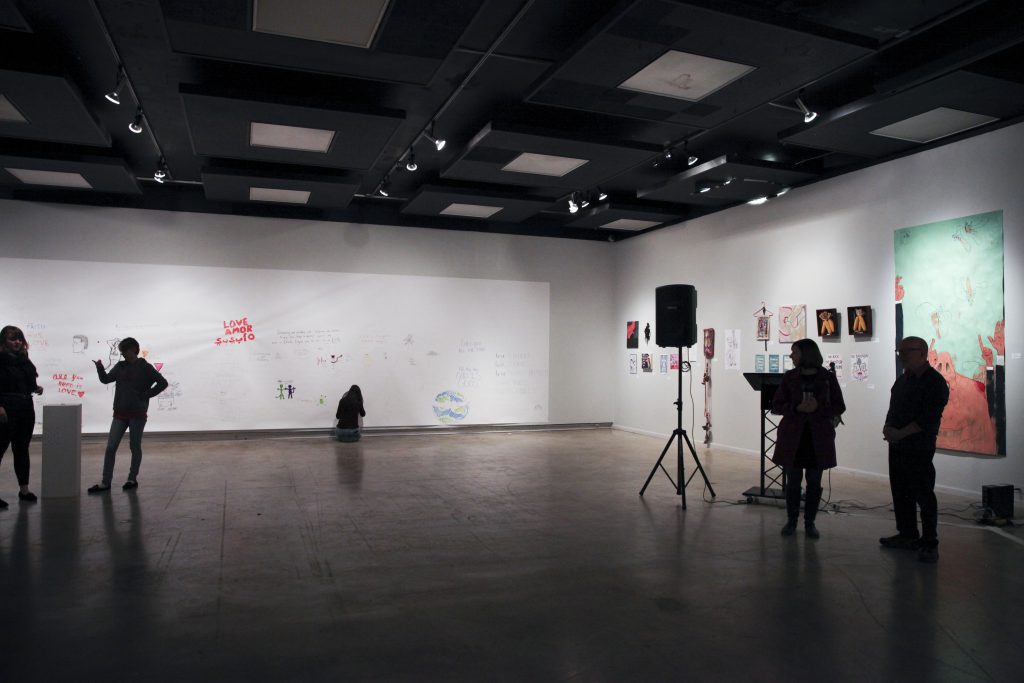
We received over 70 works from across campus and the community. They included everything from video work to drawings with crayon. Professional artists, young children, and artists from both sides of the aisle brought in their work. For those who didn’t have time to submit work, or were unable to contribute, we hung a 40-foot wall of paper. High school students, professors, and those who stopped in drew, wrote, glued rhinestones, and responded. It allowed for a spontaneous space, something we felt was therapeutic and supportive of all those who came in.
In the end the show became a gathering place, transforming itself to become what the visitor needed it to be, whether that was quiet reflection or finger painting in rage. The newly formed Arts Collective came together in incredible ways and worked to gather the artwork, the people, the emotions, and so much more. In future, the Bloomington/Normal Arts Collective hopes to foster this spirit of togetherness through creation and display in interesting and innovative spaces.
Featured Image: Entrance to CVA 110 at Illinois State University; show poster designed by Alice J Lee. Photo courtesy of Jason Judd.
Bloomington/Normal Arts Collective is one of Sixty’s Regional Partners.
 Brady Adams is currently a BA Creative Writing student at Illinois State University. He works as a content writer at a local web development company and self-released a chapbook of poems in 2015. Brady is a member of the Bloomington/Normal Arts Collective, a group of artists in central Illinois that seeks to establish an alternative scene for showing work, including artist writers that wish to maintain a thriving dialogue in the area.
Brady Adams is currently a BA Creative Writing student at Illinois State University. He works as a content writer at a local web development company and self-released a chapbook of poems in 2015. Brady is a member of the Bloomington/Normal Arts Collective, a group of artists in central Illinois that seeks to establish an alternative scene for showing work, including artist writers that wish to maintain a thriving dialogue in the area.
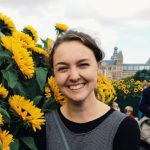
Samantha Comerford is a senior art history major at Illinois State University with a focus in contemporary curation. She is co-founder of the Bloomington-Normal Arts Collective, and runs extra\ordinary/space, an alternative art space, out of her apartment. She currently works at University Galleries, and has had experience at James Harris Gallery and MOHAI in Seattle as well as cometogetherspace in Bloomington-Normal. You can follow along with extra\ordinary/space, and some of Samantha’s other projects on the BNAC website. bnacollective.com
